#lawrence lek
Text

Lawrence Lek, Black Cloud Highway 黑云高速公路,
at Sadie Cole HQ, Davies Street, London (20 May–24 June 2023).
19 notes
·
View notes
Text
0 notes
Text

Lawrence Lek, Aidol, 2019. CGI Feature Film, Stereo Sound, 83 min
0 notes
Text

The Horizons booth at Art Dubai presenting 'Nepenthe Valley', an NFT project by Lawrence Lek. Photo: Horizons (So-Far x Aora)
0 notes
Text
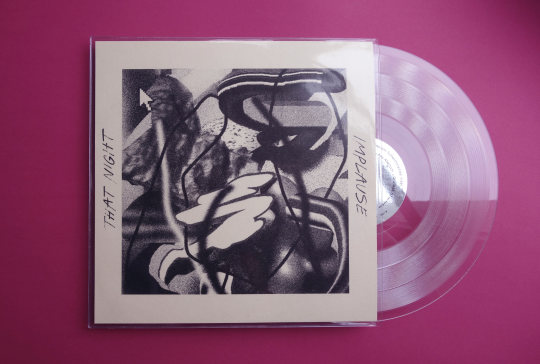




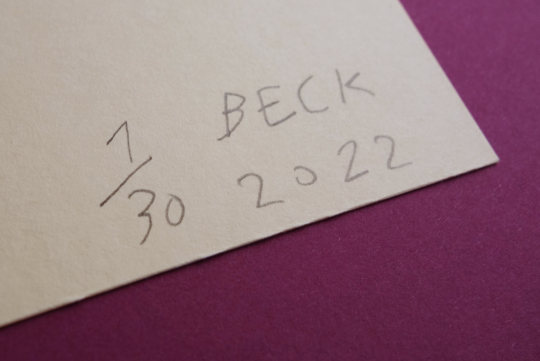
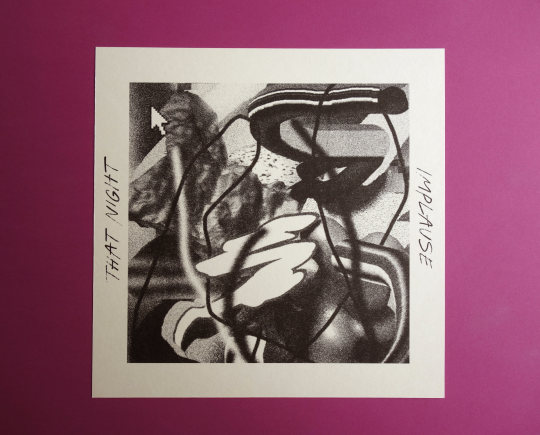
Cologne-based That Night is finally back on Noorden with his new EP »Implause«
6 tracks between a chillaxed after-hour in the zen garden of Lawrence Lek and riding a white 1983 Ford Escort Cabrio on serpentine roads. Surrounded by a warm breeze, the endless sea, and a feeling that something bad is about to happen. Heavily inspired by Twin Peaks, Neue Helvetica, and B-Movie-Soundtracks.
For the limited 10-inch-vinyl, we teamed up with Bonn-based artist Arno Beck, who did the beautiful artwork and the Risograph-printing. The edition of 30 is numbered and signed by the artist.
— clear vinyl lathe cut by Disc Archive, Berlin
— center labels printed on silber mirror foil
— Artwork by Bonn based artist Arno Beck
— Risograph printed inlay on Römerturm 300 g/m paper
— Printed, hand-numbered and signed by the artist
>> GET IT AT NOORDEN
9 notes
·
View notes
Text
instagram
From the Video Hook-Ups Archive:
Interview with Bob Bicknell-Knight
Bob Bicknell-Knight is an artist and curator based in London. He is the director of contemporary art platform isthisit? and co-founder of A217gallery.
Marilyn Roxie of VIDEO HOOK-UPS: What other curatorial platforms, online or off, inspired isthisit?
Bob Bicknell-Knight: There were a few spaces I was interested in and looked to before I launched isthisit?, particularly other digital galleries that showed me that this was an actual possibility. A few years ago I had a fairly naive sense of the internet and wasn’t even aware that online galleries existed. I remember looking at Chrystal Gallery, an online space that literally duplicated the white cube of the stereotypical gallery and Lawrence Lek’s Bonus Levels, particularly A Collective Tower. Made for Art Licks in 2013, this was essentially an artwork that transported 21 London based galleries into an interactive landscape. Still fairly close to simply duplicating the standard offline gallery setting, but that idea of interactivity really grabbed me. I was also seeing Delta Sorority’s online residency program unfold at the time, as well as generally looking at lots of websites that facilitate physical galleries too. In general though I think everything you see and do influences your practice and daily life in various ways, so it’s quite hard to pin these things down to specific inspirations.
VH: How have you found balancing your own personal art practice with curating online and off, and are there ways that these overlap?
BBK: I see everything that I do as one encompassing practice, if I were to split up these labels into different sections it would be impossible to navigate. So I see my curation as an extension of my art and vice versa which allows for a continuous overlap of ideas and interests. This is one of the reasons why I’ve inserted my own artwork into some of the exhibitions I’ve curated in the past, as they’re usually focused around ideas I’m currently interested and invested in. Obviously there are times where I’ll spend more time sending emails for my curation than making actual work, but I think that’s the same across the board these days. Artists have had to adapt and become their own promoters and gallerists, applying for funding and navigating that balance of actual art making with everything else that’s involved with the production of a new piece. So yes, everything overlaps and I think that’s an important way of keeping everything under control and manageable.
VH: What atmosphere and positive attributes do you think the format of an online exhibition lends to video that differs from the traditional physical gallery space with projections or darkened rooms? I have found that there is something intimidating particularly about people actually picking up the pair of headphones offered and listening to the audio accompanying a piece in a physical gallery space.
BBK: For me having a video work available to view in an online space is great. Being afforded the ability to actually spend time with a film, rather than continually worrying about the time or whether there’s a comfortable place to sit, is definitely a positive attribute of having access to video art on the internet. Watching a film in a gallery context can be a frustrating exercise sometimes, which usually translates to watching it when you get home on the internet, although there are many instances of the work being no-where to be found online; a slightly unexpected turn of events when every blockbuster film seems to have been pirated and streamed hundreds of thousands of times. I do understand the necessity for not having a video accessible online, digital editions, exclusivity, etc, but that doesn’t make it any less frustrating. Bearing this in mind however, when a video truly grabs you, is installed magnificently and hooked up to an incredible speaker system, truly drawing you in, it’s hard to say that it’s not the definitive watching experience.
I always think of a Jon Rafman installation; sinking into a ball pit or being trapped in a seemingly innocuous piece of office furniture. These are amazing experiences. It’s just not the same when you’re watching in bed, pausing every so often to chat to a roommate whilst simultaneously scrolling through your Facebook feed. It’s a balancing act.
In the hyper-connected world of today, constantly multi-tasking, I sometimes see an immersive video work as an excuse to simply relax into it, to put down your phone and just watch it. Who needs to check Instagram when a snake is swallowing itself in front of you? This is why VR interests me so much, you can no longer look away from the work, and it’s quite hard to take a selfie whilst consuming it.
VH: What do you see as the future of online gallery experiences, for isthisit? or more generally?
BBK: It’s unfortunate, but due to the lack of funding for the majority of online projects, isthisit? and many other spaces like it on the internet are all inherently doomed to fail, fading into the abyss where the domain name will eventually be allowed to expire. They are, and will continue to be, free cultural spaces that involve a lot of time and effort on the part of the unpaid organisers. Obviously that’s a very pessimistic point of view to have, but I feel like it’s an important aspect of these micro organisations that needs to be highlighted.
Bearing this in mind, I obviously hope to continue with isthisit? for many years to come, hopefully having a permanent physical space in the future to realise more experimental offline exhibitions, gaining sponsorships for the magazine and building a portfolio of digital artworks to sell on the shop side of the website. The increased affordability of technology like VR will definitely broaden what can be done on the internet with virtual gallery spaces, although right now there’s a widening hardware class divide that’s never going to be truly resolved. It’s a shame, but after undergoing online projects for a while, I’ve begun to realise that the internet isn’t as great as everyone wants you to think it is.
4 notes
·
View notes
Text

Nøtel (The Hague), 2018
Lawrence Lek (b. 1982, Germany)
2 notes
·
View notes
Text

📖 Article of the day: Interview: Hito Steyerl & Lawrence Lek
Credit : Fact Magazine
➡ To Read Full Article: https://www.factmag.com/2023/11/24/interview-hito-steyerl-lawrence-lek/
#repost #read #technomusic #technoculture #music #artist #electro #electromusic #article #art #interview #dj
0 notes
Text
Lecture notes: Oliver Smith and Game Changers (9.5.23)
Artists, from particular mediums/materials/processes, can pioneer what is possible in art, which allows them to be agents in change:
Creativity and innovation in materiality
Idiosyncrasies, nuances and subjectivity in concept
Other elements such as collaboration/exchange, context, critique and impermanence
“The transition from dialectics to triolectics is a commitment to experimentation, dynamism, collaboration and community…” - from Oliver Smith’s thesis (probably?)
Examples:
Asger Jorn:
Light Painting by Danish artist (1953, photographed by Paul Pedersen)
Brotherhood Above All (1962)
In the Beginning was the Image (1965)
Stalingrad (1956-1972)
Any of Lola Greeno’s necklaces
Lindy Lee’s Traversing the Nine Sections of the World (2015) and Ouroboros (to be completed in 2024 as of writing this)
Tom Moore’s Mycelium Manikin (2021)
Wim Delvoye’s Cloaca Professional (2010)
Any of Dale Chihuly’s glass works
Janet Laurence’s Deep Breathing: Resuscitation for the Reef (2019)
Simryn Gill’s Maria’s Garden (2021)
Lawrence Lek’s Nepenthe (Summer Palace Ruins Edition) (2021)
1 note
·
View note
Photo

Project Logan | Art @ Coles #45!
Opening Sunday May 7th from 4pm-8pm
Coles Bar, 2328 North Milwaukee Avenue
Chicago and the show runs through August 2023.
Exhibition features documentary photos and videos of Project Logan mural productions along with art pieces from those who have participated at the wall over the years. (2011–2023)
Project Logan was the mural wall on Medill facing Fullerton and Milwaukee and wrapped around the building which was recently torn down (behind the Liberty Bank).
Look for other events coming up this year to honor the wall!
Thanks to FLASH for co-curating this!
AnySquared organizes Art @ Coles Exhibits at Coles Bar. This is our 45th Show.
Art by: @flash_abc ; Opik28 @styrograffart ; FYSER ; AREA ; Miles Daniel ; @icy_beee ; @adrian.r_adr ; @lardomoney ; TONY ONCE ; @teamalice ; KEL ; @juan_a_cano ; @surgeon_865 ; ANDY WILLIS ; @_indio___ ; @nolatainoart ; @insidousStudios ; @DRIFROREAL ; @ZombieRecycling, @ab_surd9 ; @sunnieskiez ; @tsel_one ; @og_mad_5150 ; @skoldiloks ; @uneone
Documentary Photos of Productions by: Phife Gog Tribute by Stef Skills, Breaker Ray & Traz; DEPT Tribute by CMW 2015; Zome 2016; Omen & Sobe Bozo production 2017; Justice for Floyd production 2020; Bus production by Absurd; Slang Production 2015; Water is Life Production; Stay Home Covid 19 Production; KLTA (Kieth Lawrence Tuner) Production; Mutliple Tributes by Milt Coronado; Anti-Monsanto Production by Stef Skills, Monstrochika, Gloe, Beloved, & Orkid, Two Spirit by Natalia Virafuentes & Natalie Sustaita ; Goddess of Fuck by Squeak Starzula; Chirak Production by Leks PC Crew; Tribute to MC Little Lord from the grill by Yes, Statik, Rel, 1st, Breaker Ray ; Owl Production by Brooks Golden & Copper; Heart Logan Square Production By Risk, Chumbly, Bboyb, & Flash; NERD Painting on the Wall ; Joe Green tribute funded by SCORIPI ABC, Portrait Painted by WERM and Flash helped paint background. ROME & MAXWELL; SKETCH MUL ; CYFN PC; WENDL PC; TONY ONCE & UNEEK
And many more Project Logan Productions featured in video presentation.
______
AnySquared Arts NFP | Supporting and nurturing artists, and creating community for over 13 years, AnySquared is a collaborative network and an artists platform. Propelled by a profound sense of cooperation with artists, neighbors, and the larger community, our mission is to support projects that promote inclusive participation in arts activities. Our foundation is the belief that we can accomplish anything if we work together.
______
AnySquared.org
News: anysquared.tumblr.com
IG: @ne2_gallersquared
YouTube, TikTok, Twitter, & Facebook : @AnySquared
[email protected]
0 notes
Text

IM SCHILF DER STADT – Music and ambience selected by That Night.
»Im Schilf der Stadt« is a dreamy, floating and yet in places driving mix with ambience and atmosphere from films that can be assigned to the cyberpunk genre. Listening to it automatically draws pictures in your head – kind of like Moebius drawing Blade Runner and 川井 憲次 playing music while transforming into a Ghibli character.
The 90 minutes mixtape is handdubbed in a limited edition of 25. The TDK SA90 comes with a hand painted black matte top – plus 1c printed inlay in original TDK vintage clear case. (Girl from Kushiro-Shi illusioned by MT Nobo)
>> LISTEN TO THE MIX
Tracklist:
A)
Palmbomen II – Hopeful 01
Unknown Me – Gaze On Your Palm
Lawrence Lek – In The Game
Visons – Segerfalk
Pier Luigi Andreoni & Francesco Paladino – Aeolyca Pt.1
Tomaga – Reverie For Fragile Houseplants
Futuro Antico – Concrete Music - Oa Oa
Geinoh Yamashirogumi – Illusion
Hinako Omori – Spaceship Lament
Andrew Pekler – Avian Modulations
Midori Takada – Mr. Henri Rousseau‘s Dream
B)
FSOL – Dead Skin Cells
Jeff Mills – The World Of Worlds
Model 500 – The Passage
Burial – Antidawn
Lawrence Lek & Oliver Coates w/ Joni Zhu – Dragons
Kenji Kawai – Type 2052 „Hadaly“
group A – Initiation
Antenna – They Won‘t Regret
Bill Nelson – A Short Drink From A Certain Fountain
Star Searchers – Intertidal Shadezones
David Whittaker, Tim & Lee Wright – Game Over
Actress – Voodoo Posse Chronic Illusion
6 notes
·
View notes
Photo
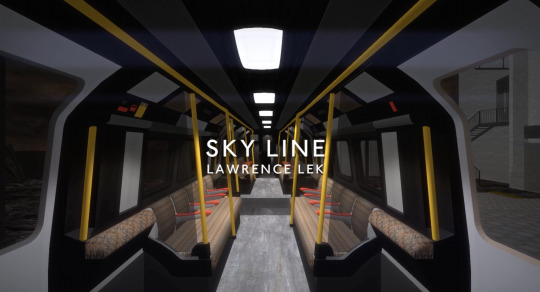
FROM THE ARCHIVE OCTOBER 2014: SKY LINE by Lawrence Lek Interactive VR, Download Game & Installation, A Brooks Art @ Artlicks Festival, London, 2014.
Multi-screen HD video installation: 2 interactive real-time simulations with game controllers, one 5-minute video loop, artist gaming installation pavilion.

Sky Line is a utopian virtual world based on London, where players explore a new transportation network that connects galleries and project spaces across the city. Modelled as a floating version of the Circle Line, each station is based on a location participating in the Art Licks Weekend festival, the work is set on a railway that connects twenty independent art galleries with its curatorial concept and physical architecture adapted to its digital double in time and space at the station stop. The Hackney stop features A Brooks Art.


#lawrencelek#skyline#bonus levels#ARTLICKS#festival#a brooks art#video#gaming#installation#independentgalleries#projectspace#play#mindthegap#stationstop#artistledspaces#multiscreen#explore
0 notes
Photo
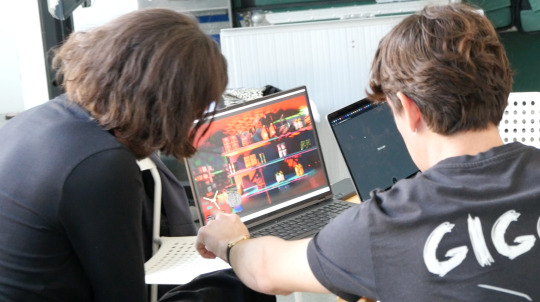
DMSTFCTN on developing the GOD MODE game
The goal of our game GOD MODE: EPOCHS is training the AI character, which is called UntitledAI. It will be multiplayer, streamed online, people taking turns to control different parts of the simulation.
In general we’re feeling our way through how to design and make games, which is not what we do normally. We’re not really launching a commercial game, it’s an experiment to find out a lot of things. We prototyped it first functionally, not visually, because it needs automation for certain parts.
We’re aiming for a standalone version of one scene from the performance GOD MODE (ep. 1), which is the moment where the AI trains: moving around a supermarket, picking and learning items. In AI training systems, typically you have a focal object and distraction objects. That’s already the interactive part of the performance, and not so much part of the narrative; the AI is talking about its experience while it’s doing it, but this is not the prologue that explains what it is, and it’s not the epilogue which is more poetic. This part is contained, it has a goal, it’s more ‘gamifiable’.
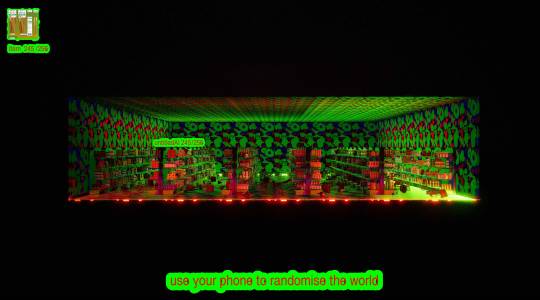
In our performance, we controlled the view, choosing when to scan an item, for example. That would be one player’s role in the game. In the performance, the audience can change the lighting, drop objects from the ceiling, re-texture things, to make the training harder. Players of the game will have one of those abilities as well. Collectively, those abilities make the world more complex, so that what the AI learns is more robust. So as a player, you’re not a character as such, but an action – you have a role.
There’s a key problem we identified in representing training. We were talking about reinforcement learning, which is typically not used for computer vision. It’s not a big deal since we’re in a speculative space anyway, but we don’t want to open ourselves up to critique. So we’re thinking about what kind of training our AI is engaged in, and we’re thinking about what that means for finding a bug – this is a key moment in the narrative. This opens up past memories, and more broadly enables automated systems to do things they weren’t intended to do.
Having stories of other AIs who escaped is important to us. You have collectibles in games, so these could be little fragments of history. How do we show people the bug has been found? Before, we had a little frame that showed what it was supposed to look for, then that became empty, which showed the bug, and it became self-aware in a different way.

BUILDING WORLDS & CHARACTERS
In the introduction section of the performance, where the world is being generated, the AI says things like, ‘On top of nothing, floor. On top of floor, shelves.’ That’s a kind of specification language we took from something called iGibson, which is Stanford’s synthetic robot training software. We use that to suggest that the world is created in a structured way, and there’s a particular language to it, which has an impact on the way it can be considered. Currently, the AI’s voice says those words, and we’re thinking about whether to change that. We think of it as the debugger, and then there’s the more personal experience of the AI character. We’re rethinking whether this should be two voices inside the AI’s head, or two characters. One of Lawrence Lek’s recent works, Black Cloud, has a conversation, in a sort of smart city of the future which is deserted, and it seems like it’s a conversation between a CCTV camera and a self-driving car. Parts of a system conversing with each other.
We’re also guided by this game Disco Elysium. You’re a detective and you wake up with no memory. It’s kind of a role-playing game, in the sense of capabilities. You have sections of your psyche in conversation, interjecting in different ways. There’s one part, for example, that makes you more intuitive but also more susceptible to addiction.
The game came from a guy, a musician, who’d written a novel in this same world, and it didn’t sell particularly well, he had a bit of a crisis, but then decided to push through the crisis by making the world’s most complicated piece of media – a role-playing video game. And it’s been incredibly successful.
This helps us think about how we differentiate different aspects for people, through point of view, rendering style, view modes. How is the voice characterised? Thinking of TV shows like Peep Show, or Lawrence Lek’s Black Cloud. Or this gaming trope which is a voice with an internet connection – your helper, that tells you, ‘You should be looking for a red box, remember?’
We’re thinking that no one moves around – it’s automated, on rails, like the game Time Crisis from way back when. We first thought players could walk around themselves, before we realised that once you put more than two views on the screen, the graphics card explodes. How might points happen? We’re kind of keen to have a leader board. Kind of arcade-y. Is there a timer? We don’t want to do it in a sort of ‘dark patterns’ way, but a game needs to hook you in somehow.
We were inspired by worldmodels.github.io: it learns to play Doom by learning what Doom looks like, and then sort of hallucinating Doom, and training inside the hallucination rather than inside Doom itself. So it encodes patterns from the game. And then, in the same way that image-generation AIs are the reverse of image-learning AIs, it then uses that to hallucinate and replicate lots of variations of gameplay in Doom – cheaper than running the game over and over again.
It’s very nicely written up – one of the best websites of an academic paper I’ve ever seen; it loads and runs little parts, you can play with all the weights and models and stuff. What’s interesting in this is that it has a vision model and a memory model, which feed into each other and into a controller, which then decides what to do. And there’s feedback on how to do that better. This is not too far off of some models of the human brain, and also interesting in relation to what Katherine Hayles says about embodiment – it’s mimicking but is it the same? What if it’s not embodied? This helps us think what our UntitledAI is – is it a vision model, navigation, debugging? We hope to explore this more in future versions.
We’re thinking of changing the way the character’s face looks and works, to better represent the lifeworld of the character. It’s already made up of supermarket items, like a weird Arcimboldo painting. But if all it knows is what it’s learnt and seen, and if it’s inventing the representation of itself based on this, should that change over time? We made an initial version, and I’d read a couple of things, but we threw it together without really explaining what’s behind it. It worked and we used it in the performance. In addition to Arcimboldo, it also contains some ideas from Katherine Hayles, and Barthes’ analysis of Arcimboldo’s paintings – the way that they’re metaphors. We made the first version from the supermarket kit that we bought – a Sweetheart candy heart, KitKat fingers, etc. Slightly silly.
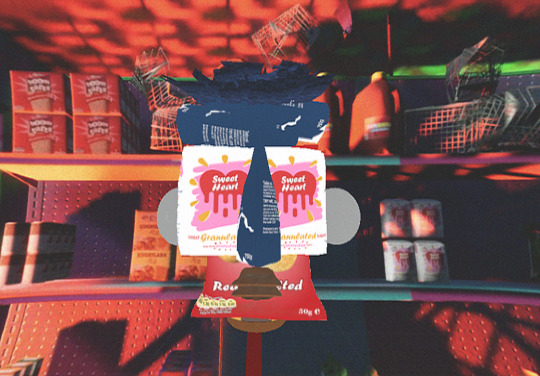
SYNTHETIC DATA
We’re using a supermarket level creator kit you can buy for Unreal Engine. We didn’t want to, and couldn’t, model everything. And we’re interested in how the rise of synthetic data comes from existing tools and data. Of course a real supermarket presumably substitutes its own real products at some point, but for a certain amount of time they can use these existing kits. There are massive 3D repositories, similar to ImageNet, and like ImageNet they’re scraped from TurboSquid, Sketchup repositories, etc. At some point we’d like to work with one of those and pull things in.
In commercial synthetic data, vendors talk about data being ‘perfectly labelled’. In a technical context, it is perfectly labelled – I’ve got a model of a car, my system takes that model, assigns it the label ‘car’, and the image that comes out is a perfectly labelled model of a car. But that ignores the way that someone assumes and categorises that to be a car – the way it’s been brought into the world, the system that’s behind it. This is one of our critiques.
We also looked at some military uses – where synthetic data and its assumptions might be extra problematic. For example automated tanks trained within video games, like navigation using Doom or Starcraft. We moved away from that because it’s hard to know – it’s a secretive world. We might move to that in another episode. But we also wanted to move away from being purely didactic: military = bad, therefore synthetic data + military = obviously bad.
All this is helping us move into Episode 2, because this was always intended as a series.
1 note
·
View note











